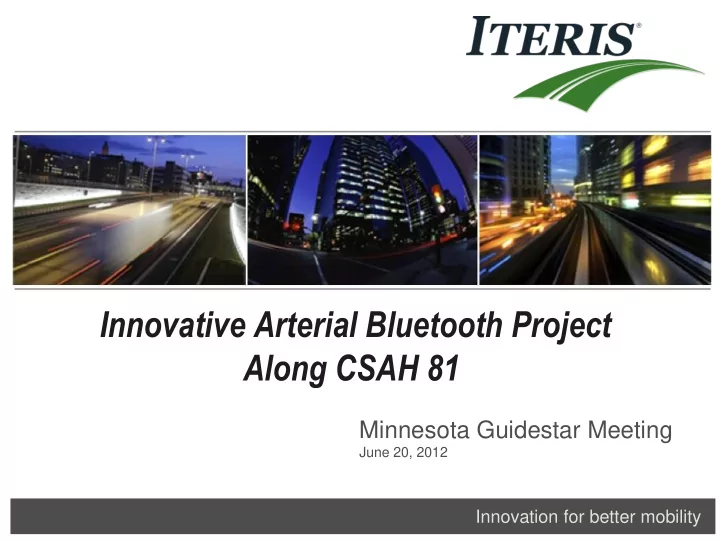

Innovative Arterial Bluetooth Project Along CSAH 81 Minnesota Guidestar Meeting June 20, 2012 Innovation for better mobility
Project Background Minnesota Department of Transportation (MnDOT) issued RFP for the 2009/2010 ITS Innovative Idea Program asking for projects that demonstrate ongoing advances in technology Iteris was selected for project that measures travel times on an arterial corridor in Hennepin County, MN using Bluetooth technology Project started in July 2009 and ended in January 2011 Can Bluetooth Readers provider accurate arterial travel time Information? Innovation for better mobility
Why are we monitoring arterial Travel Times? Measuring arterial travel times is beneficial for improving: – Signal timings – Arterial planning & planned improvements – Traveler information Travel time is the foremost indicator of the quality of traffic flow currently in use Travel time is intuitive and easy to understand Innovation for better mobility
Project Location Six signalized intersections on CSAH 81 corridor in Hennepin County, MN ADT 10,000 – 25,000 vehicles Innovation for better mobility
Technology Deployment Spacing along arterial: 1.7 to 3 miles between locations 6 Locations, 8 Readers Each intersection location: – Bluetooth Reader – GPS receiver – 3G modem for backhaul At corridor end locations: – One side communicates to other side via 5 Ghz Wifi network Innovation for better mobility
Preliminary Field Tests Conducted field survey – Capture rate of BT signals 36 th side 36 th median 42 nd Bass Lake 63 rd Omni 6.7% 11.4% 7.7% 3% 5.4% – Availability of 3G signal (Sprint) • All locations: download 500kbps – 1.5Mbps, upload 200 Kbps – 550 kbps – WiFi interference level • Detected WiFi signals with 25%-39% signal strength – Documented “floating car” travel times for future comparison – Connection to the web portal Innovation for better mobility
Intersection Layout Innovation for better mobility
StreetWAVE ► Integrated with 3G, WiFi, DSRC, GPS, Bluetooth in a single platform ► 24v dc (standard) ► Single radio will support diverse applications simultaneously ► One-way, 2-way, individual and broadcast communications ► Ruggedized NEMA enclosures to fit all weather needs Innovation for better mobility
StreetVIEW Portal Provides a map with device locations and their operational status Raw data is stored unfiltered in relational database Statistics Display – Number of BT reads at a location in specific interval – Table display of travel times for user-definable links – Scatter plot of travel times Innovation for better mobility
Web Portal Innovation for better mobility
Dynamic Information Innovation for better mobility
Travel Times Innovation for better mobility
Set-up & Filtering Initial configuration easy for the agency to deploy system. No need to do travel time runs to deploy along a corridor. – Use Posted Speed Limit Filtering algorithm needs to be smart enough to allow average speed to approach 0 mph. – Look at previous (1 min.) interval average speed if it is declining then drop the lower limit of the filtering. Innovation for better mobility
Addresses Matched to Travel Time Runs Tracked the unique MAC address through the database to Bluetooth enabled laptop running PC Travel for travel time runs completed. Innovation for better mobility
Trend Analysis Innovation for better mobility
Travel Time Runs bound Bluetooth Data Innovation for better mobility
Conclusions/Lessons Learned With calibration and verification, Bluetooth readers can provide accurate travel time information for corridors with ADT greater than 15,000 ADT. Don’t need two readers at the end of the corridor. Antenna coverage is not an issue. Place Bluetooth readers 400’ feet from intersections or place at low volume side street intersections. Innovation for better mobility
Future Applications Origin/Destination Studies Prioritization of Corridors for Traffic Signal Retiming 511 Travel Time Information/Traveler Information Innovation for better mobility
Questions & Answers For Additional Information: Lisa Raduenz Steve Garbe, PE ljr@iteris.com spg2@iteris.com 612.371.9200 402.476.5101 Innovation for better mobility
Recommend
More recommend